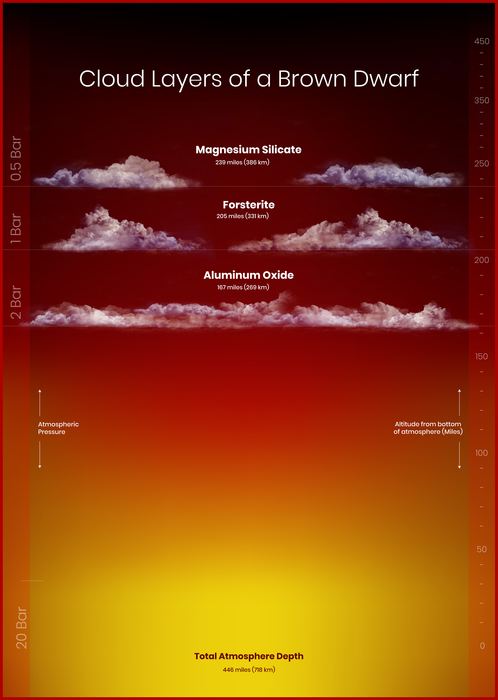Astronomers peer at 'layer cake' levels of a would-be star to understand super Jupiters
This study might whet your appetite for exoplanets.

Our cosmic block is full of neighbors that we know very little about, but scientists have come up with a creative new way to get a peek at the layers of one particular type of planet.
Super Jupiters are just what they sound like: massive gaseous exoplanets that can be up to 13 times larger than our neighborhood Jupiter. To understand these worlds better, scientists behind new research used "failed stars" called brown dwarfs as a proxy.
Brown dwarfs are balls of gas up to 80 times Jupiter's mass that nearly became stars but never crossed the finish line. While too big and isolated to be considered planets, brown dwarfs do not have enough mass to experience nuclear fusion and become true stars.
Related: Many nearby Earth-size exoplanets could be hiding in plain sight
Elena Manjavacas, an astronomer at the Space Telescope Science Institute in Baltimore, led a group of astronomers to study the "layer-cake" structure of the clouds belonging to a brown dwarf with the lengthy moniker 2MASS J22081363+2921215.
Although astronomers have successfully analyzed the composition of some super Jupiters, Manjavacas and the team substituted brown dwarfs because the details of these smaller planets' clouds can get lost in the glare of their parent stars. Studying solitary bodies like the brown dwarf in their new paper, which will be published in The Astronomical Journal, helps them avoid that problem.
The substitution also works because super Jupiters and brown dwarfs have a lot in common: they are massive, reach similar temperatures and feature varied atmospheres.
Get the Space.com Newsletter
Breaking space news, the latest updates on rocket launches, skywatching events and more!
The brown dwarf in the new study is young and very bright, so it radiates heat strongly in the near-infrared part of the electromagnetic spectrum. The team hoped that getting a detailed look at 2MASS J22081363+2921215 would help them learn about the atmosphere of a super Jupiter called Beta Pictoris b, which was discovered in 2008 and has roughly the same mass as the brown dwarf. Both worlds share the same origin and are part of the group of objects called the Beta Pictoris moving group, which is located 115 light-years away from Earth.

To get a look at the turbulent atmosphere of the brown dwarf, which rotates every 3.5 hours, researchers used the Multi-Object Spectrograph for Infrared Exploration (MOSFIRE) instrument on the W. M. Keck Observatory on Maunakea in Hawaiʻi.
MOSFIRE could analyze the signatures of different chemical elements contained in the clouds, and the team then used computer models to anchor observations to their corresponding altitudes. The fast pace at which the brown dwarf rotated meant that some cloud tops parted as they whipped around, creating breaks where the deeper layers could be observed.
Manjavacas' team found traces of potassium iodide in the brown dwarf's atmosphere (which also includes magnesium silicate), then underneath that, a layer of sodium iodide and magnesium silicate, followed by aluminum oxide clouds at the bottom.
A version of the study was posted on July 26 to the preprint server arXiv.org.
Follow Doris Elin Urrutia on Twitter @salazar_elin. Follow us on Twitter @Spacedotcom and on Facebook.
Join our Space Forums to keep talking space on the latest missions, night sky and more! And if you have a news tip, correction or comment, let us know at: community@space.com.

Doris is a science journalist and Space.com contributor. She received a B.A. in Sociology and Communications at Fordham University in New York City. Her first work was published in collaboration with London Mining Network, where her love of science writing was born. Her passion for astronomy started as a kid when she helped her sister build a model solar system in the Bronx. She got her first shot at astronomy writing as a Space.com editorial intern and continues to write about all things cosmic for the website. Doris has also written about microscopic plant life for Scientific American’s website and about whale calls for their print magazine. She has also written about ancient humans for Inverse, with stories ranging from how to recreate Pompeii’s cuisine to how to map the Polynesian expansion through genomics. She currently shares her home with two rabbits. Follow her on twitter at @salazar_elin.









